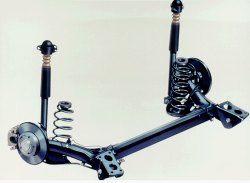 |
| McPherson wheel suspension |
In the first comment on this post Bob Stuart, the designer of The Car-Cycle X-4,
argues that the McPherson is one of the lightest options. In our design of a micro electric car (Elite) we used an alternative construction. It is a sort of torsion beam suspension. Because the distance between the wheels is so little, this construction may be lighter than the McPherson. Another advantage is that it incorporates the anti-roll function.
 |
| This drawing shows the wheel suspension of the Elite micro electric car. It was mounted to the body via silent blocs |
The McPherson construction distributes the wheel load over six distant points on the monocoque. Large torque loads will be transferred as small forces in these points (braking, cornering). This seems all very beneficial but the McPherson construction urges us to strengthen the monocoque at places where we really don't need it to be strong at all, would we not have this suspension. When we use a McPherson suspension we are forced to add material at the mounts of the longitudinal arms and vertical columns. We also have to increase the lateral rigidity, for instance with an u-frame between the front wheels. This may increase the body mass. The torsion beam axle connects to the monocoque at the front side of the seat. This is a place where we need it to be strong and stiff anyway...
 |
| Torsion beam suspension |
The McPherson is one of the lightest options for a monocoque, which is able to accept the spring loads up high and wide. The monocoque is otherwise somewhat heavier, but can give better safety. The same geometry can be used with a transverse leaf spring supporting a backbone frame, and this option gives an anti-roll bar function as well, by mounting to the chassis along two axes. It has the advantage of using a single part for both structure and spring, devoting almost no weight to the lower link of the McPherson geometry.
ReplyDeleteSuspension can do far more than make skinny tires feel like fat ones. With more travel, the ride and handling can get better still. Solid spring elements are inescapably bulky or heavy, although they allow a lighter supported frame, in proportion. Elastomers are an order of magnitude better than steel springs, and can act as dampers. See Miner Rubber's Bumpers, or arrange things to use bungee cord. Air springs are potentially much lighter still, and can incorporate air dampers and even micro generators. Like rubber, they have the additional advantage of giving a rising rate, which requires less damping and is particularly suited to vehicles with wide variations in load. They also work well with the McPherson arrangement, and can have an anti-roll circuit added.
Bob Stuart
I like this plywood velomobile blog, especially because of the weight consiousness. Keep up the good work!
ReplyDeleteBeing from a rather hilly area (~15 % inclination), I wonder wheather you will use drum brakes (again) or disc brakes.
*PLEASE* use disc brakes, so that all the other manufacturers who just copy dutch VM suspension systems, finally learn how to build real VMs.
Thank you very much.
Peter
I would like to develop the body only. I hope others will do the work on suspension, drive line, soft top, etc etc. Disc brakes are a very good choice naturally. When Bart Verhees build his first Alleweder (~20 years ago) disc brakes for bikes were not on the market and he build his own. Now we can even choose the type we like best...
ReplyDeleteA more problematic theme however is the drive line. I choose the simplest alternative for now: Rohloff. But in the future we could have some kind of linear or elliptic pedal track and front drive. That would increase traction and we could get rid of the large hole under the crank axle.